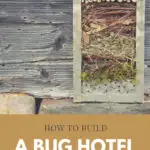
With plenty of time on your hands, has your mind ever wandered to the garden, and to how you might go about attracting beneficial insects to your space?
If so, you may have found your own intuitive answer in the form of a bug hotel. Something that gives both your mind and your creative hands something interesting to do.
Introducing a bug hotel helps nature too, allowing for a beautiful win-win situation.
Constructing a bug hotel is an easy project, giving you something meaningful to do, and to observe as the beneficial insects come flying and crawling in at their own pace.
Overall, a bug hotel is a wonderful learning experience for all ages.
That being said, let’s burrow into the reasons you might want to go out, design and make a bug hotel for your backyard this very weekend.
5 Reasons To Make a Bug Hotel
Bug hotels range in size from the smallest of the small (as we will show in pictures how to make further on) to the largest and most complex natural boxes you can imagine.
They can often be found in community gardens, outdoor classrooms, atop green roofs and along fences.
In essence, bug hotels attract a variety of valuable visitors such as ladybugs, spiders, bees and woodlice. Bug hotels provide such insects with a safe shelter where they can lay eggs and/or raise their young. It can also act as a place of refuge – for example when you mow the lawn. Naturally, if you choose to stop mowing your lawn (or to simply mow it less), the bugs are going to love that aspect of your yard too!
The two in combination, a bug hotel paired with less mowing, can make a real impact to the rewilding of your garden.
Let’s invite some bugs to inhabit our shared habitat!
1. Bug hotels attract beneficial insects
Ask any organic gardener and they will tell you how their crops were pollinated by flying insects, the apples and plums in the orchard too. While tomatoes and squashes can be hand-pollinated, try doing that to a mature fruit tree. Impossible, isn’t it!
Bugs are something that every gardener needs, in all shapes, colors and sizes. For they do so many things for us, that we simply cannot do.
There are those that specialize in pollination, and those that help reduce the populations of other detrimental insects.
Solitary bees, for example, nest in hollow stalks and stems, or underground holes in sand or clay. How often do you see unmaintained prairie areas with dried stalks around your area? In a bug hotel you can provide some habitat specifically for them.
Ladybugs prefer to overwinter in larger groups and are happy for a bundle of twigs and a blanket of leaves.
Spiders, lacewings and beetles will have their own nesting preferences.
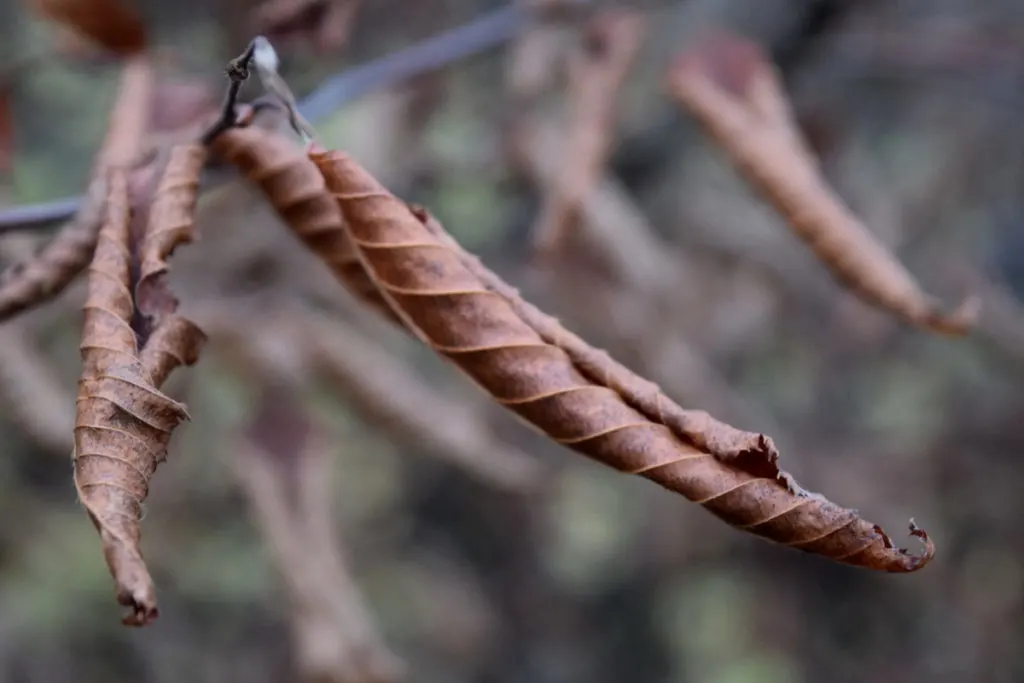
The more variety you can provide in each bug hotel you make (yes, you may end up making more than one!), the better your chances are that your hotel will be occupied. Though never at full capacity.
2. You have plenty of space to share
Loss of habitat is a real and all-too-serious thing. Not just for large creatures who need miles and square miles to find food as they stretch their long adventurous limbs. Insects, too, need help in finding a safe place to live out their, often very short, lives.
Commercial farming, through the use of excessive pesticides and insecticides “necessary” for production, has wiped out many winged and crawling creatures in the previous decades. In 2019, a study suggested that “40 percent of insect species are in decline”. As the world grows louder with human noise, massive swaths of monoculture crops, deforestation that outweighs tree planting and ever faster movement beyond even our own Earth, let’s not wait to hear the quiet majority (the beneficial insects) grow ever more silent.
If you have a backyard, no matter how big or small, you have plenty of space to share. A balcony? You still have enough space to invite nature close. It is all about living in harmony with nature, which includes not being afraid of it.
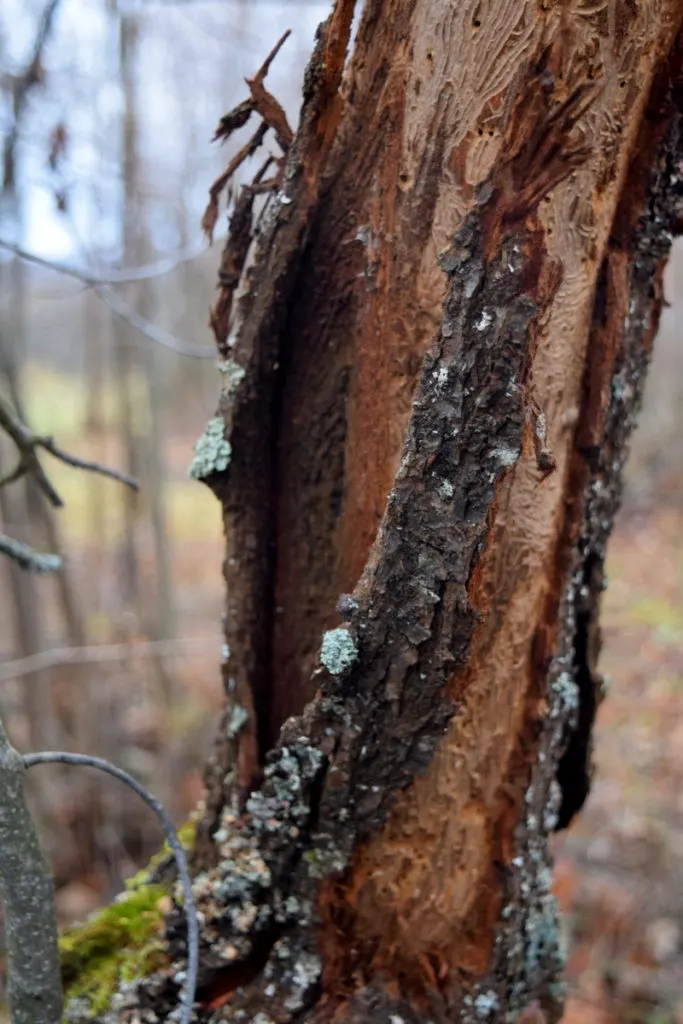
3. Increase your awareness and understanding of nature
What you don’t understand can hurt you, in more ways than one.
If you think it is necessary to remove every leaf from the ground in autumn, you are mistaken. Though you may not feel the repercussions first hand, your garden will. Those fallen leaves are also beneficial, for they turn into mulch, compost and eventually soil. All without your help. In the meantime, they act as a natural bug hotel, providing grounds for insects to overwinter, later to be found as food for birds that stay the winter.
When we continuously break the fantastic cycles of nature, we only have ourselves to blame.
The remedy is this: lose your fear of the things you do not know or recognize. Try to understand them instead. Get a book about bugs and begin to know them by sight. What are their habits, how long do they live?
Then get curious. Why should we encourage certain spiders in our garden? What is the life cycle of a seemingly invasive caterpillar on a patch of nettle?
When we can turn fear of the unknown into curiosity for our surroundings, nature is in a better place. After all, many insects can just look scary, but they really aren’t.
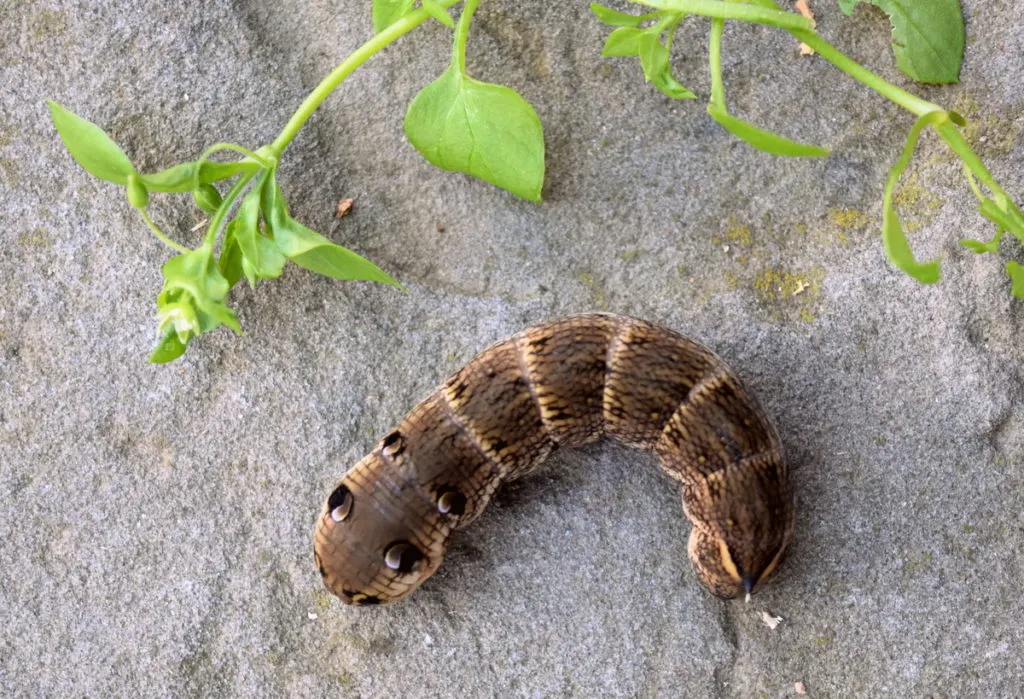
Take a look at this beautiful elephant hawk moth caterpillar we found in our yard while scything our lawn. If we have been using a mower, we might not have been able to relocate it to a safe place.
4. Add visual interest to your garden or backyard
Bug hotels can be as simple or elaborate as you wish.
Several years ago at the Jardin des Plantes in Paris, we happened to stumble across, after a very long day of walking, a large area dedicated to insect hotels, and were amazed at the possibilities they had to offer!
But, you don’t need to make it to Paris to know that some of those hotels were buzzing.
Making a bug hotel is a wonderful creative project that only needs to take as much time as you have energy to put into it. Setting the artistic value aside, a bug hotel is functional too. This can only increase its value in the landscape.
5. Make a bug hotel to increase your outside activity
Bug hotels are not just for adults. Children can get in on the fun and action of making them too. In collecting the natural materials, in layering them, and finally in observing and coming to enjoy the many creatures that crawl and fly in and out.
A bug hotel can even be a place to hang out (outside) and spend time with. Not only can you sip your coffee, or an evening glass of homebrewed hard apple cider (pollinated by the bees) by the bug hotel, you can also use it as a source of inspiration.
Building a bug hotel together even promotes a sense of teamwork and community spirit. So, what are you waiting for?
When to make and set out a bug hotel?
Beneficial insects are in need of shelter all throughout the year. And the best time to build a bug hotel is when you can find both the materials and time to put it together.
However, autumn may still be the best time to set your bug hotel out, as many creatures will begin to seek hibernating space at this time.
As with hanging a bat house, some things are just ready when they are ready. If no insects are ready to move in, at least you can enjoy it for a project well-done.
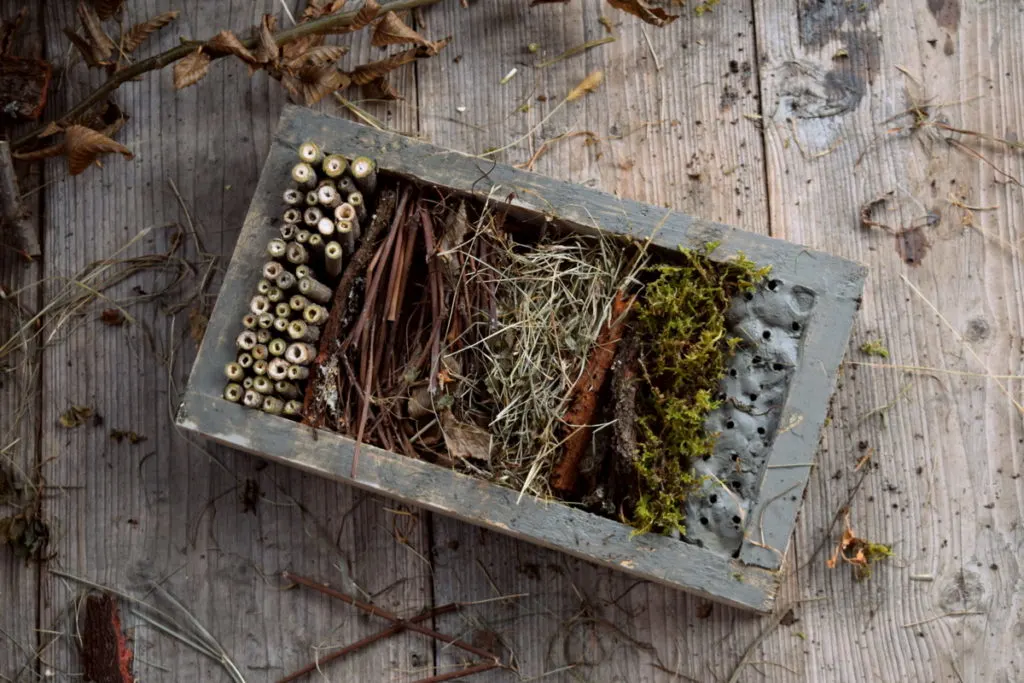
Naturally your handmade bug hotel will have visual appeal as well. In that case, hang it with love in your backyard, as you imagine all the beneficial insects to come.
Collecting material to build a bug hotel
What kinds of materials go in a bug hotel?
Just about anything and everything that you can collect nearby, from nature, of course.
Keep it plastic free (as you pick up litter in the landscape), in favor of collecting material from the insects’ native habitat.
If you happen to live closer to the great outdoors, or can only dream of moving out to the countryside for more space and fresher air, chances are good that bug houses are already and naturally plentiful. Such as this pile of branches and leaves below.
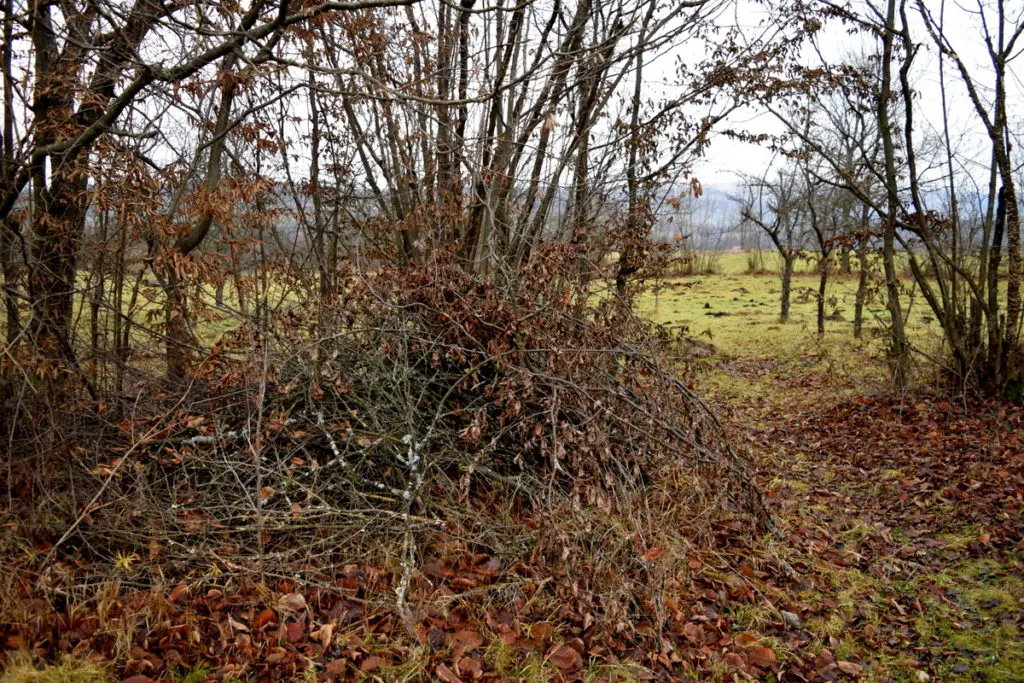
As you go out on a short hike, or stroll in a park, start collecting the following items for your bug hotel. It goes without saying, only pick from those areas and properties where you have permission.
Collect more than you think you will need, as it takes quite a bit of material once everything is compressed together in the frame.
Gather your supplies:
- scrap piece of untreated wood, about 3 ft. (1 meter), cut into 4 pieces
- 2 x 14″ (35 cm)
- 2 x 6″ (15 cm)
- width of board: 2 3/4″ (7 cm)
- extra board for the back, optional
- nails or screws
- saw
- hammer and/or drill
- a handful of willow or hazel branches for the back of the frame, optional
For the wood, first think about how large you want your bug hotel to be. Remember that they come in all shapes and sizes. Cut your untreated board accordingly.
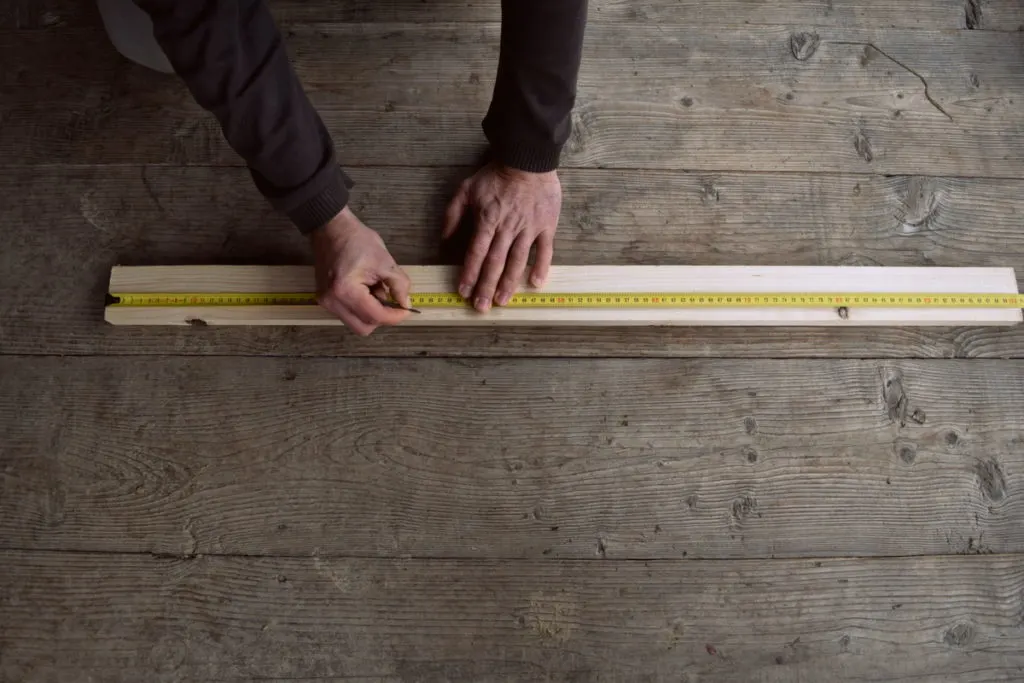
There is no magic size for a bug hotel, use the best material you can find.
Collect your natural materials too:
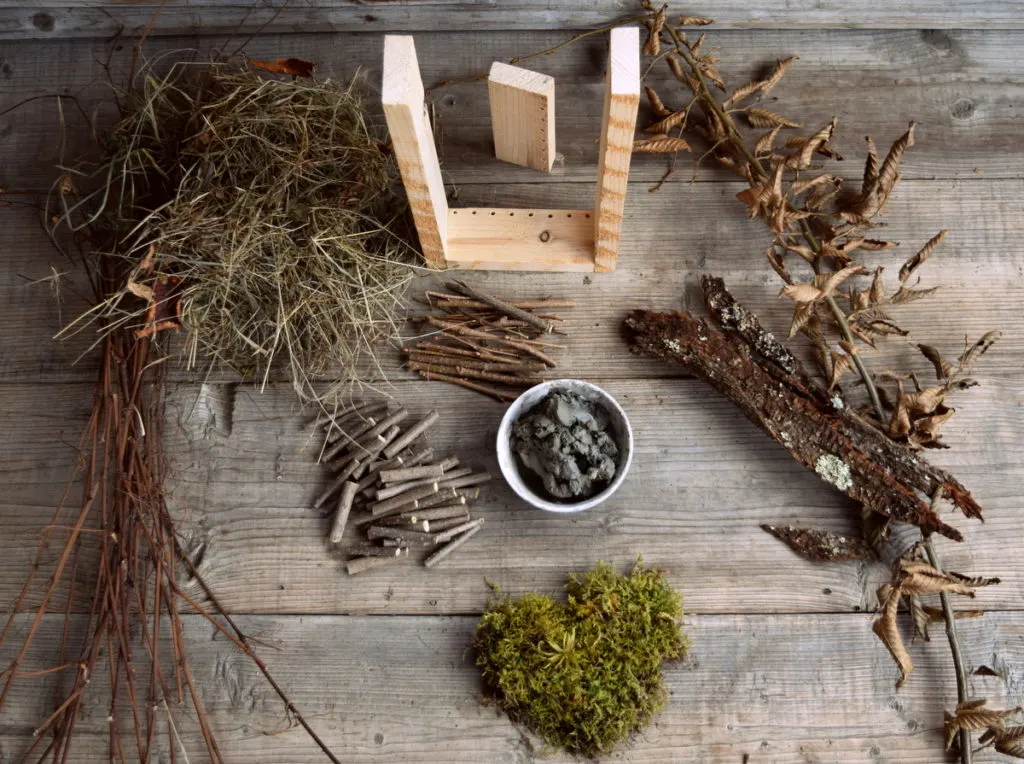
- leaves
- bark
- moss
- sticks
- clay
- hay
- dried wildflowers
- grapevines saved from summer pruning
- pine cones
If you have been planning to make a bug hotel, or are just starting to think about it, give yourself plenty of time to collect these natural materials. Get children involved in the process too! What better way to learn about how nature works, than to observe it firsthand.
Go on a leaf and stick hunt, sneak in some words about biodiversity and gently touch on the subject of climate change, but most of all, have a good time observing the beauty of nature.
Many bug hotels include bamboo as an essential element for harboring solitary bees. We have chosen not to include it in our mountain bug hotel. For by us in the mountains of northern Romania, bamboo is a non-native species.
Our native alternative is elder (Sambucus nigra).
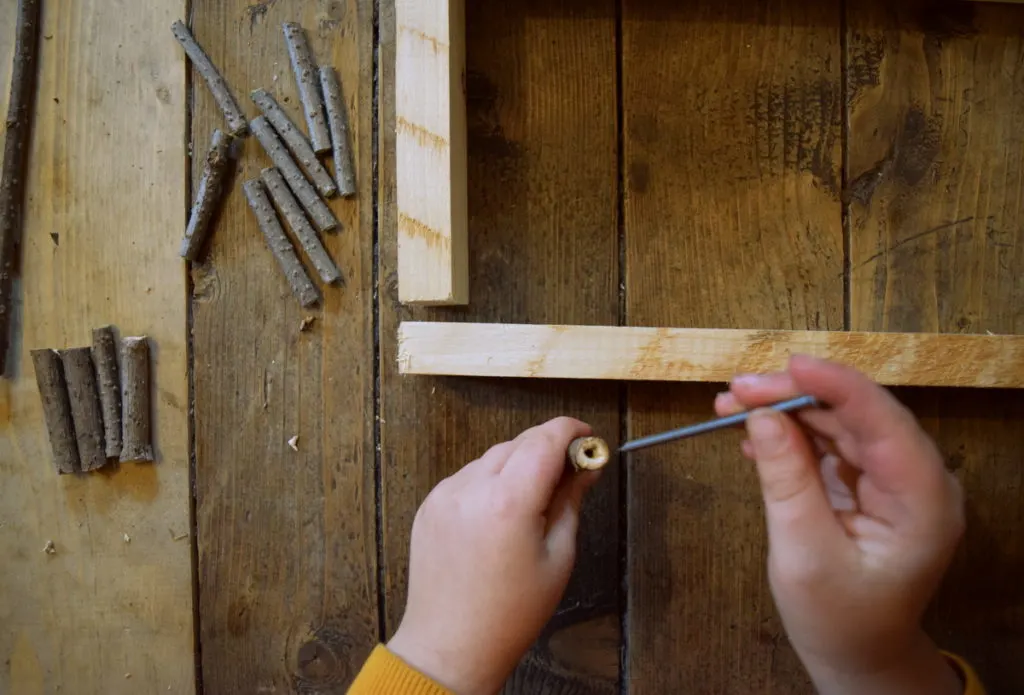
Cut the elder branches to size and push the pith out with a long nail or wire.
Set them aside for later use.
Constructing the back of the bug hotel
Before you get to the more complicated – and fun – front of the bug house, you need to think about the back. For the simple reason that your material doesn’t fall straight through.
There are two ways to construct the back of your bug hotel. One is extraordinarily uncomplicated. Attach a corresponding size of board, either nailed or screwed, onto the back. A few hammer hits and it is done.
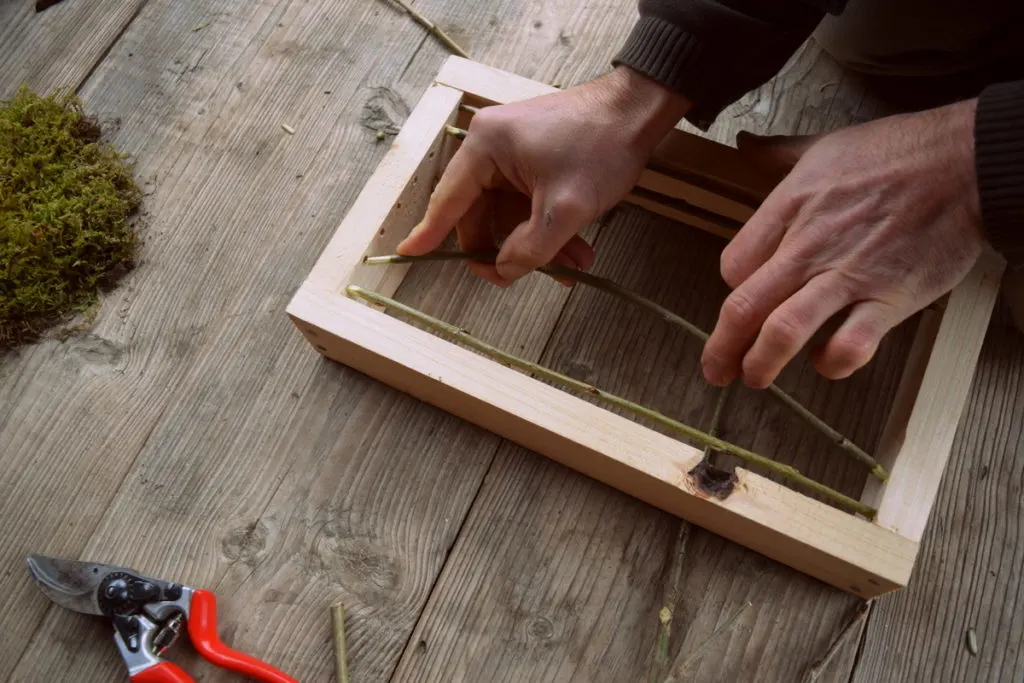
Our slightly more complex way was to take flexible willow branches (hazel would work too) and incorporate them into the wood via a series of drilled holes.
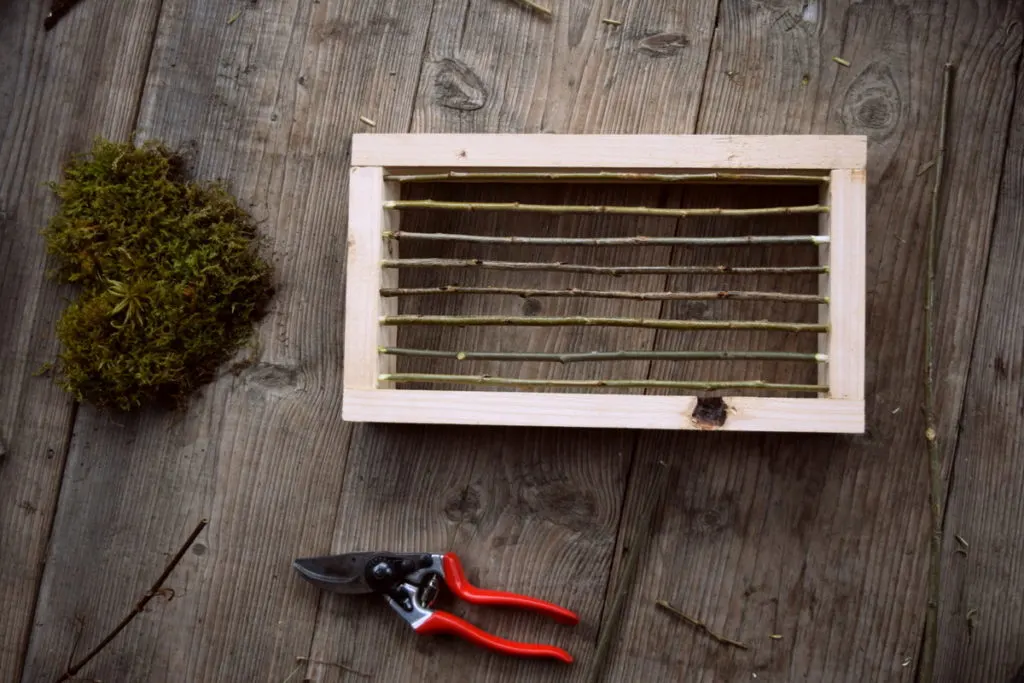
Putting the bug hotel frame together
Preparation work takes the bulk of time, so be sure you have at least a few hours, or more(!), to put this project together.
That being said, a bug hotel is a fantastic weekend project with an abundance of rewards to come.
Construct the frame in your size, so you can fill it with everything the insects like.
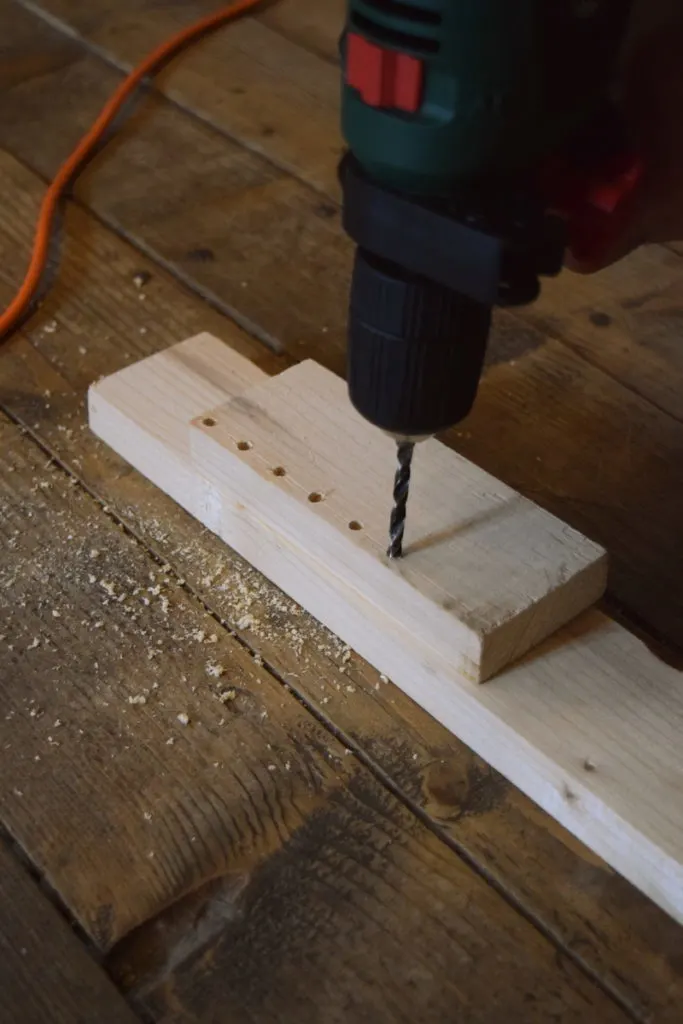
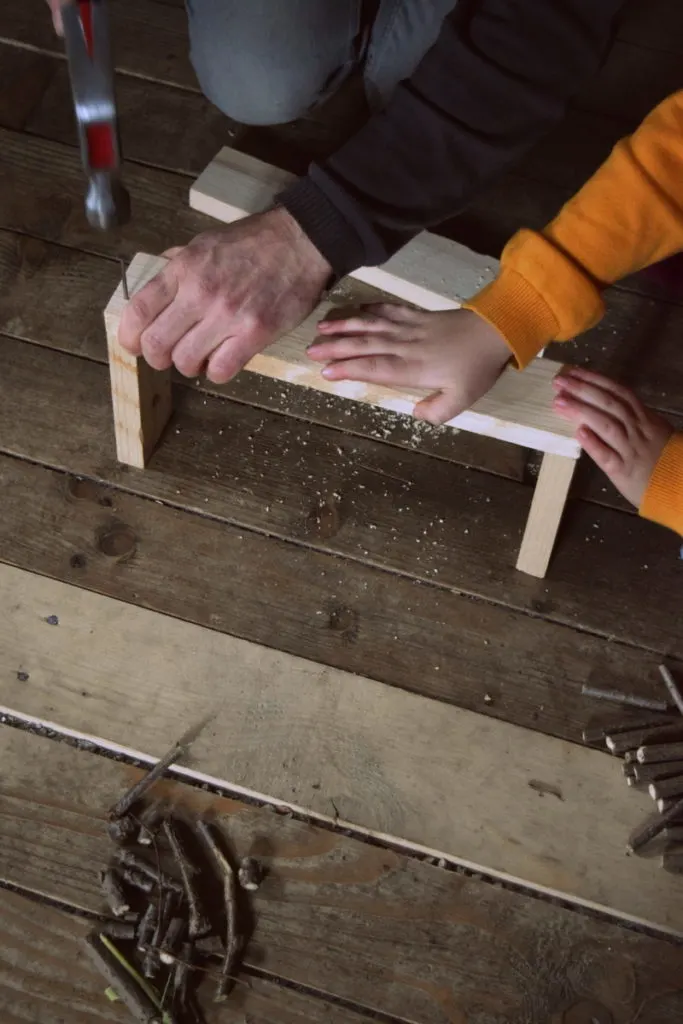
Once your frame is complete, add a back. Then move onto the best part…
Filling the bug hotel with rooms, chambers and secret passageways
For a real hands-on bug hotel building experience, work outside and allow your hands to get dirty as you create a garden masterpiece.
Arrange your materials around you and dive into the project, starting at the bottom and working your way up.
First pop in some sticks (cut to the right length) and massage some wet clay over them, pressing down as firmly as you can.
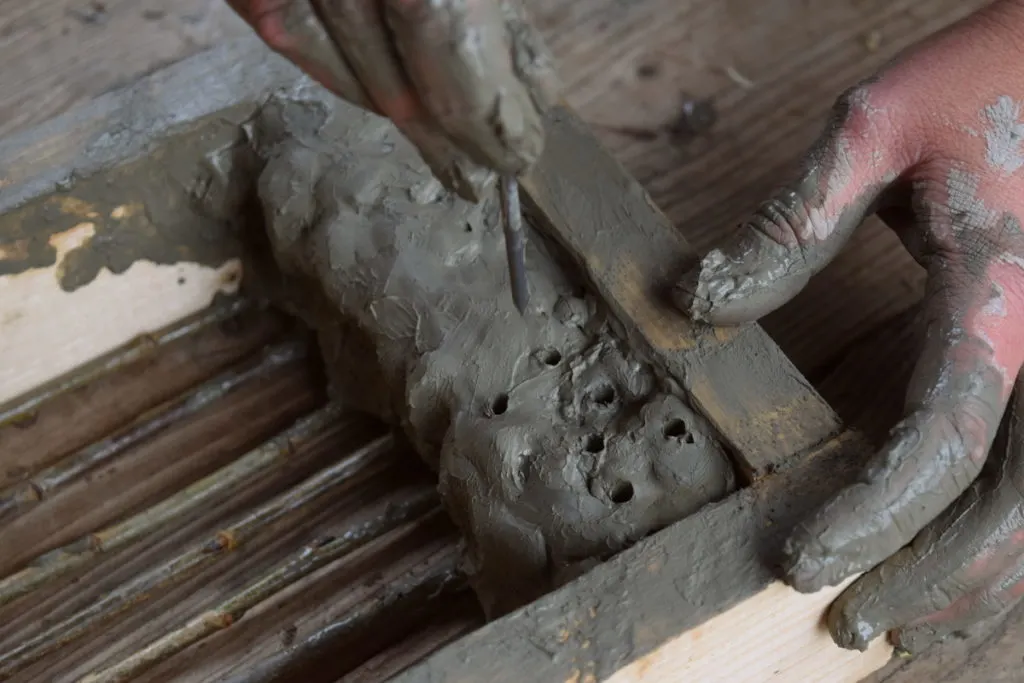
Then grab some carefully harvested moss. This element is optional. Only use it, if it is in abundance near you. Here, moss covers entire rocks.
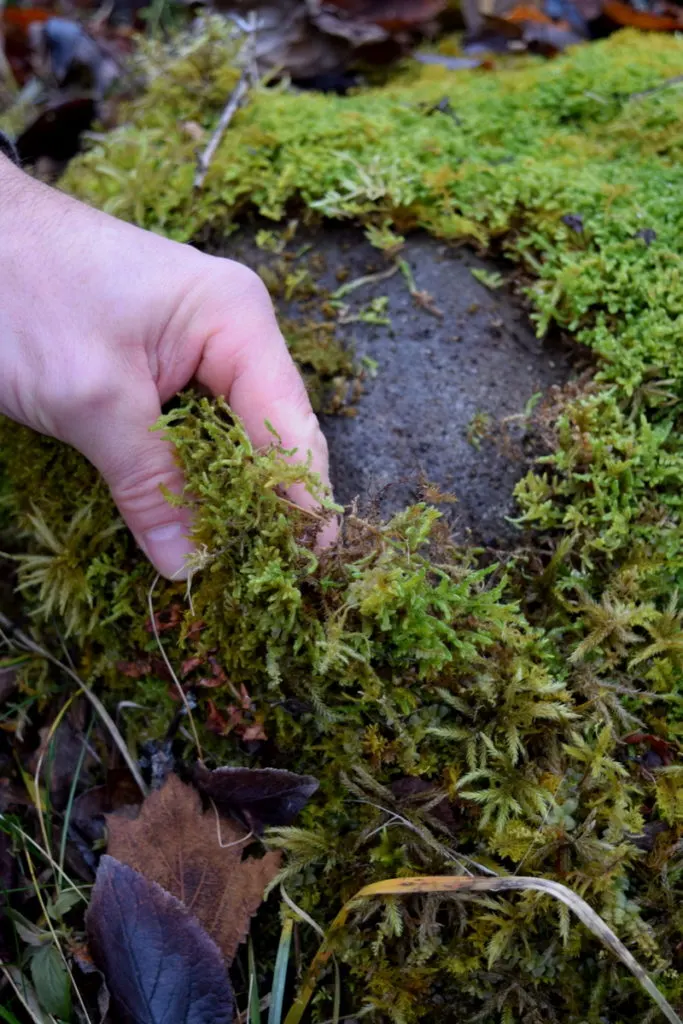
We take only as much as we need, leaving the rest at its place for wildlife.
Tuck some moss into your bug hotel as you grow the various layers.
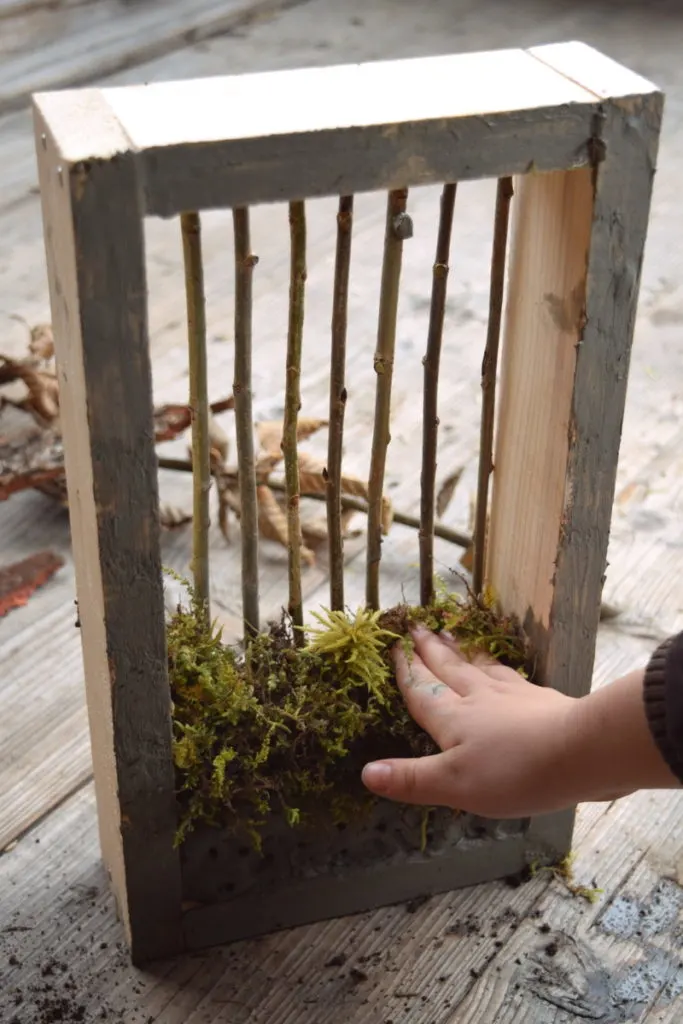
Then add some harder layers of bark. If it is broken to the right size, you can just squeeze it in, pressing it down to make the “rooms” as small and tight fitting as possible.
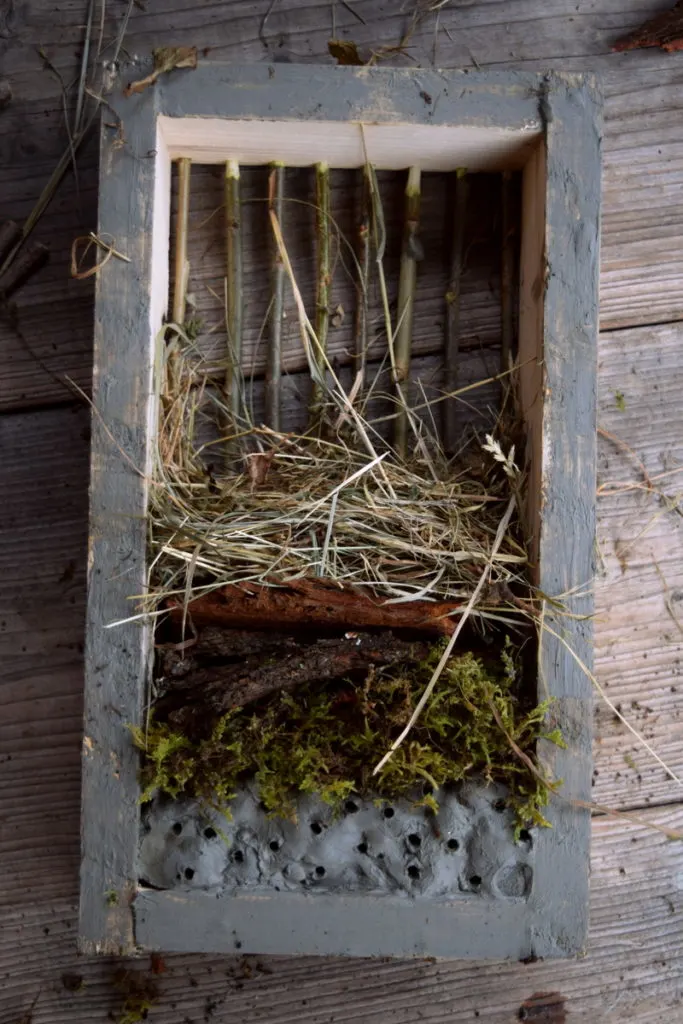
Then you can add hay, dried grasses or other dried wildflowers to create a cushion-like sponge for insects to overwinter in.
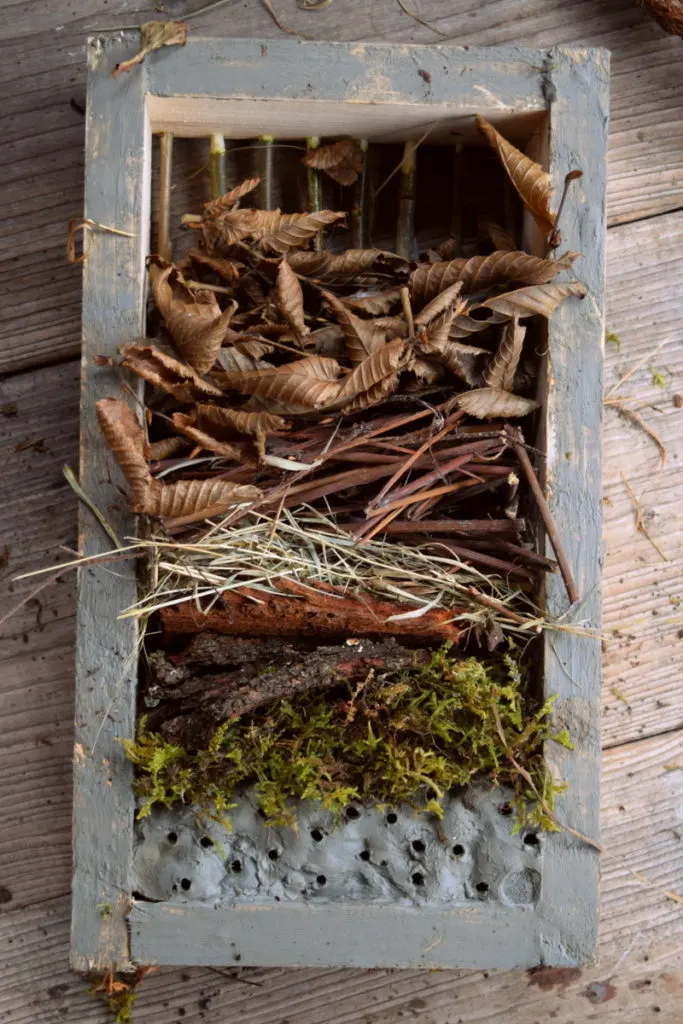
On top of the dried grass, you can add healthy leaves and branches to the bug hotel. Never use diseased plants. Always provide the best possible habitat for the insects!
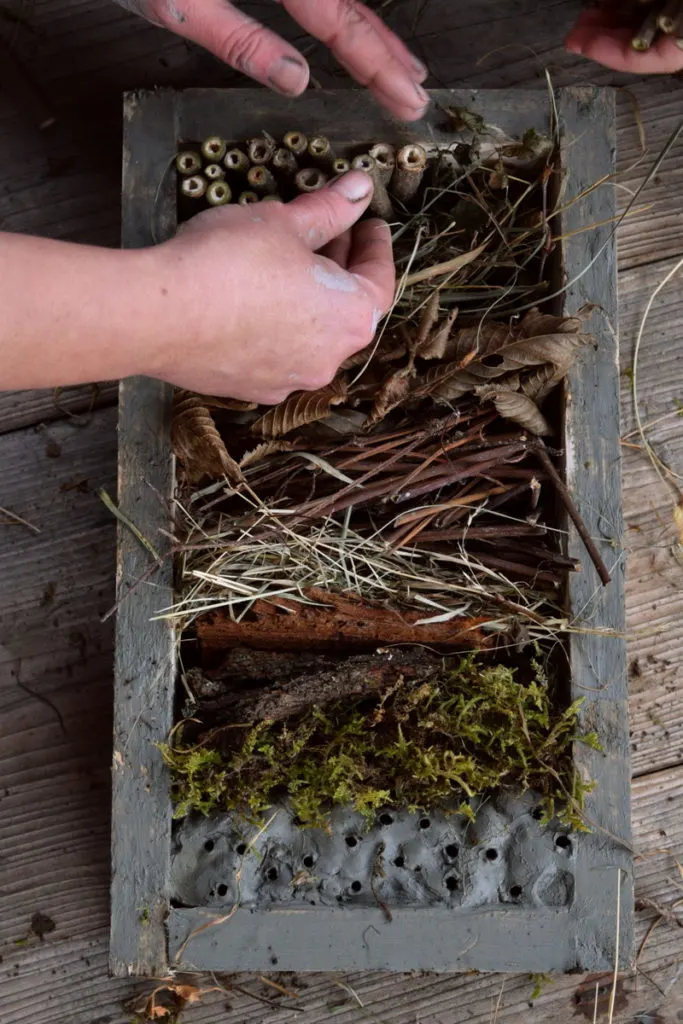
Finally, stuff in as many elder branches (or bamboo) as you can to finish off the rooms.
A bug hotel from behind
If you have chosen to go with a board on the back of your bug hotel, then you already know exactly what it will look like.
On the other hand, if you decided it would be more adventurous to try and bend some branches to fit your frame, you may end up with something more like this:
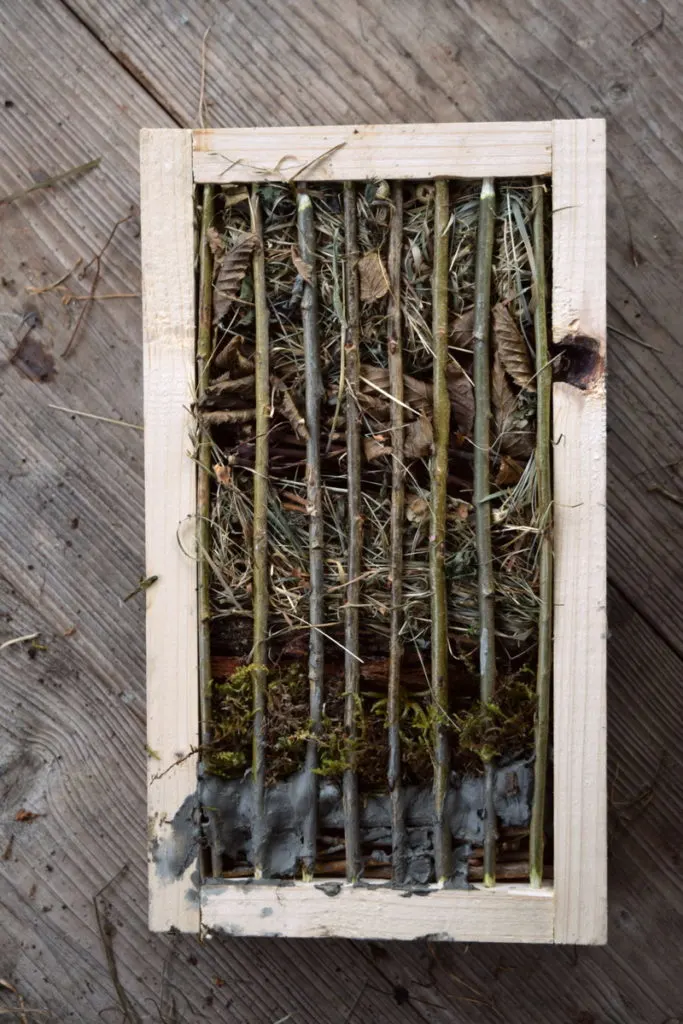
Layer upon layer of natural materials, waiting to be utilized by insects big and small, fuzzy or not, winged or wingless.
Now, where is the best location for your new bug hotel?
Since insects will be attracted to warmth, the best place for your bug hotel is a south-facing wall or fence. Possibly in full sunlight, or with partial shade.
Your proximity to nature will greatly enhance your real estate success – as will your efforts of rewilding your garden.
Adding a water feature to attract birds, bees, and other insects will only increase your occupancy rate.
But the story doesn’t quite end here. You will also need to spend some time doing your own housekeeping. That is, maintaining and cleaning your insect hotel from time to time.
Eventually it will need to be replaced as well – just as nature cleans up every year, so should you. Mold can build up in your bug hotel. Mites and parasites too. Don’t let the maintenance factor stop you from attracting beneficial insects to your garden. Just make sure you are attracting the right sort of tenants!
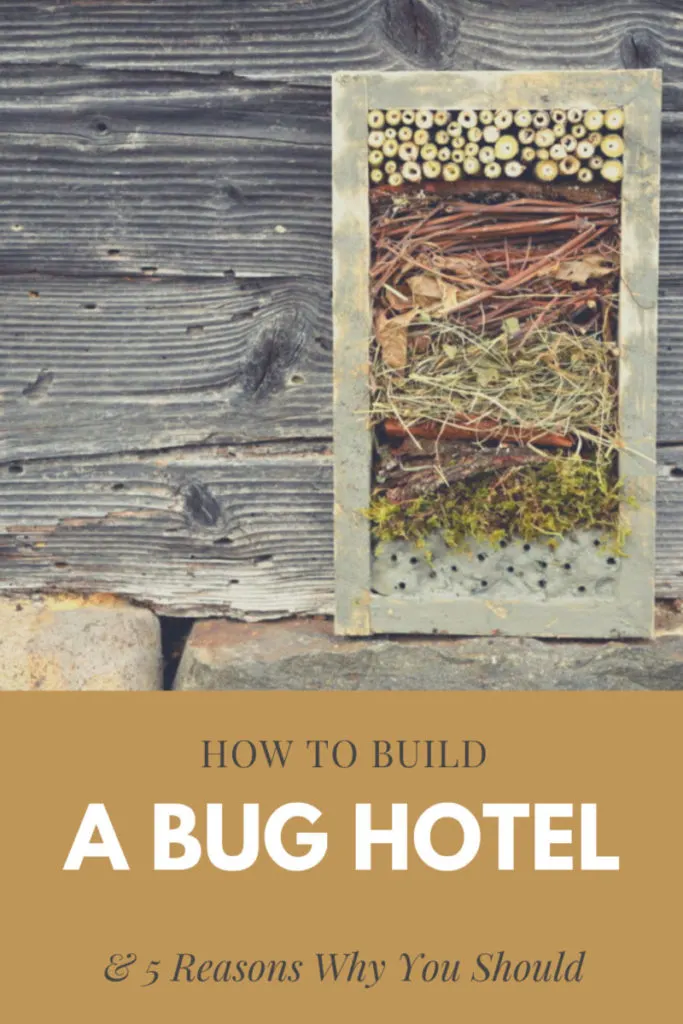

Get the famous Rural Sprout newsletter delivered to your inbox.
Including Sunday ramblings from our editor, Tracey, as well as “What’s Up Wednesday” our roundup of what’s in season and new article updates and alerts.


